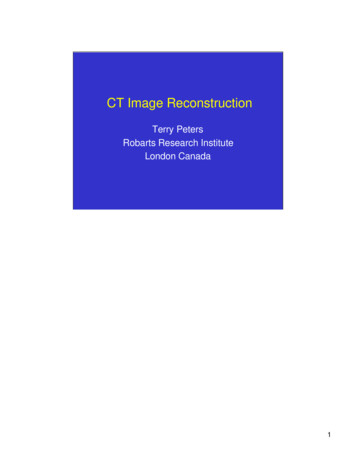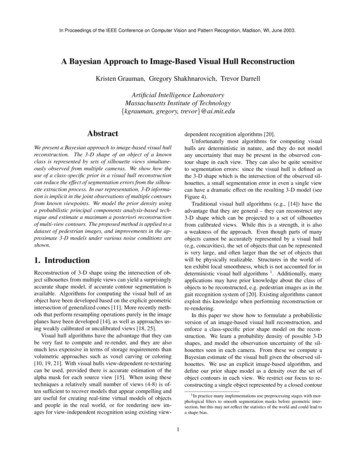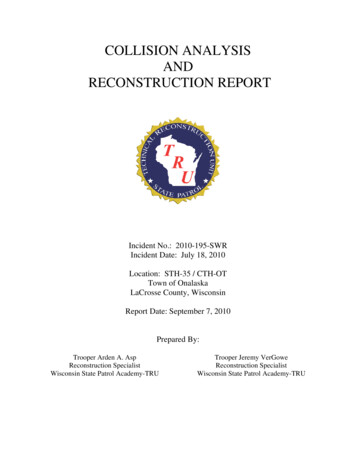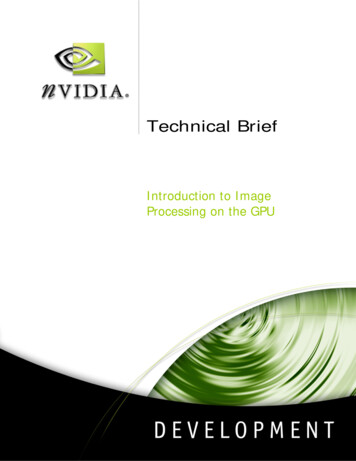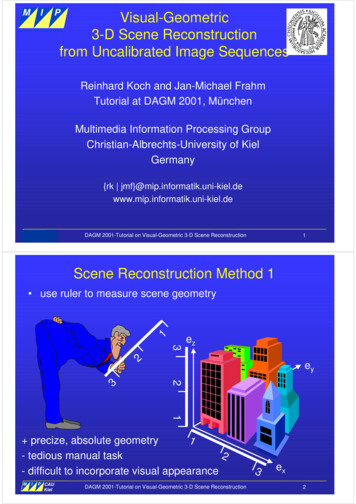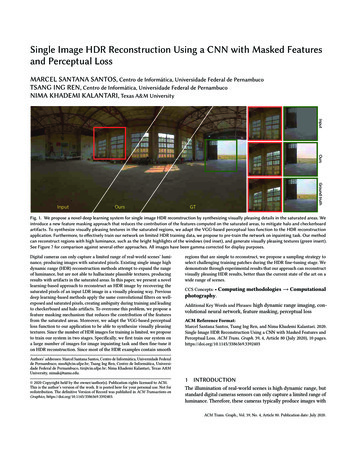
Transcription
Single Image HDR Reconstruction Using a CNN with Masked Featuresand Perceptual LossMARCEL SANTANA SANTOS, Centro de Informática, Universidade Federal de PernambucoTSANG ING REN, Centro de Informática, Universidade Federal de PernambucoNIMA KHADEMI KALANTARI, Texas A&M UniversityInputOursOursGTOursGTGround truthInputFig. 1. We propose a novel deep learning system for single image HDR reconstruction by synthesizing visually pleasing details in the saturated areas. Weintroduce a new feature masking approach that reduces the contribution of the features computed on the saturated areas, to mitigate halo and checkerboardartifacts. To synthesize visually pleasing textures in the saturated regions, we adapt the VGG-based perceptual loss function to the HDR reconstructionapplication. Furthermore, to effectively train our network on limited HDR training data, we propose to pre-train the network on inpainting task. Our methodcan reconstruct regions with high luminance, such as the bright highlights of the windows (red inset), and generate visually pleasing textures (green insert).See Figure 7 for comparison against several other approaches. All images have been gamma corrected for display purposes.Digital cameras can only capture a limited range of real-world scenes’ luminance, producing images with saturated pixels. Existing single image highdynamic range (HDR) reconstruction methods attempt to expand the rangeof luminance, but are not able to hallucinate plausible textures, producingresults with artifacts in the saturated areas. In this paper, we present a novellearning-based approach to reconstruct an HDR image by recovering thesaturated pixels of an input LDR image in a visually pleasing way. Previousdeep learning-based methods apply the same convolutional filters on wellexposed and saturated pixels, creating ambiguity during training and leadingto checkerboard and halo artifacts. To overcome this problem, we propose afeature masking mechanism that reduces the contribution of the featuresfrom the saturated areas. Moreover, we adapt the VGG-based perceptualloss function to our application to be able to synthesize visually pleasingtextures. Since the number of HDR images for training is limited, we proposeto train our system in two stages. Specifically, we first train our system ona large number of images for image inpainting task and then fine-tune iton HDR reconstruction. Since most of the HDR examples contain smoothregions that are simple to reconstruct, we propose a sampling strategy toselect challenging training patches during the HDR fine-tuning stage. Wedemonstrate through experimental results that our approach can reconstructvisually pleasing HDR results, better than the current state of the art on awide range of scenes.CCS Concepts: Computing methodologies Computationalphotography.Additional Key Words and Phrases: high dynamic range imaging, con-volutional neural network, feature masking, perceptual lossACM Reference Format:Marcel Santana Santos, Tsang Ing Ren, and Nima Khademi Kalantari. 2020.Single Image HDR Reconstruction Using a CNN with Masked Features andPerceptual Loss. ACM Trans. Graph. 39, 4, Article 80 (July 2020), 10 rs’ addresses: Marcel Santana Santos, Centro de Informática, Universidade Federalde Pernambuco, mss8@cin.ufpe.br; Tsang Ing Ren, Centro de Informática, Universidade Federal de Pernambuco, tir@cin.ufpe.br; Nima Khademi Kalantari, Texas A&MUniversity, nimak@tamu.edu. 2020 Copyright held by the owner/author(s). Publication rights licensed to ACM.This is the author’s version of the work. It is posted here for your personal use. Not forredistribution. The definitive Version of Record was published in ACM Transactions onGraphics, IONThe illumination of real-world scenes is high dynamic range, butstandard digital cameras sensors can only capture a limited range ofluminance. Therefore, these cameras typically produce images withACM Trans. Graph., Vol. 39, No. 4, Article 80. Publication date: July 2020.
80:2 Marcel Santana Santos, Tsang Ing Ren, and Nima Khademi Kalantariunder/over-exposed areas. A large number of approaches propose togenerate a high dynamic range (HDR) image by combining a set oflow dynamic range images (LDR) of the scene at different exposures[Debevec and Malik 1997]. However, these methods either have tohandle the scene motion [Hu et al. 2013; Kalantari and Ramamoorthi2017; Kang et al. 2003; Oh et al. 2014; Sen et al. 2012; Wu et al. 2018]or require specialized bulky and expensive optical systems [McGuireet al. 2007; Tocci et al. 2011]. Single image dynamic range expansionapproaches avoid these limitations by reconstructing an HDR imageusing one image. These approaches can work with images capturedwith any standard camera or even recover the full dynamic rangeof legacy LDR content. As a result, they have attracted considerableattention in recent years.Several existing methods extrapolate the light intensity usingheuristic rules [Banterle et al. 2006; Bist et al. 2017; Rempel et al.2007], but are not able to properly recover the brightness of saturatedareas as they do not utilize context. On the other hand, recent deeplearning approaches [Eilertsen et al. 2017; Endo et al. 2017; Leeet al. 2018a] systematically utilize contextual information usingconvolutional neural networks (CNNs) with large receptive fields.However, these methods usually produce results with blurriness,checkerboard, and halo artifacts in saturated areas.In this paper, we propose a novel learning-based technique toreconstruct an HDR image by recovering the missing informationin the saturated areas of an LDR image. We design our approachbased on two main observations. First, applying the same convolutional filters on well-exposed and saturated pixels, as done inprevious approaches, results in ambiguity during training and leadsto checkerboard and halo artifacts. Second, using simple pixel-wiseloss functions, utilized by most existing approaches, the network isunable to hallucinate details in the saturated areas, producing blurryresults. To address these limitations, we propose a feature masking mechanism that reduces the contribution of features generatedfrom the saturated content by multiplying them to a soft mask. Withthis simple strategy, we are able to avoid checkerboard and haloartifacts as the network only relies on the valid information of theinput image to produce the HDR image. Moreover, inspired by image inpainting approaches, we leverage the VGG-based perceptualloss function, introduced by Gatys et al. [2016], and adapt it to theHDR reconstruction task. By minimizing our proposed perceptualloss function during training, the network can synthesize visuallyrealistic textures in the saturated areas.Since a large number of HDR images, required for training a deepneural network, are currently not available, we perform the trainingin two stages. In the first stage, we train our system on a large setof images for the inpainting task. During this process, the networkleverages a large number of training samples to learn an internalrepresentation that is suitable for synthesizing visually realistictexture in the incomplete regions. In the next step, we fine-tune thisnetwork on the HDR reconstruction task using a set of simulatedLDR and their corresponding ground truth HDR images. Since mostof the HDR examples contain smooth regions that are simple toreconstruct, we propose a simple method to identify the texturedpatches and only use them for fine-tuning.Our approach can reconstruct regions with high luminance andhallucinate textures in the saturated areas, as shown in Figure 1. WeACM Trans. Graph., Vol. 39, No. 4, Article 80. Publication date: July 2020.demonstrate that our approach can produce better results than thestate-of-the-art methods both on simulated images (Figure 7) andon images taken with real-world cameras (Figure 9). In summary,we make the following contributions:(1) We propose a feature masking mechanism to avoid relying onthe invalid information in the saturated regions (Section 3.1).This masking approach significantly reduces the artifacts andimproves the quality of the final results (Figure 10).(2) We adapt the VGG-based perceptual loss function to the HDRreconstruction task (Section 3.2). Compared to pixel-wise lossfunctions, our loss can better reconstruct sharp textures inthe saturated regions (Figure 12).(3) We propose to pre-train the network on inpainting beforefine-tuning it on HDR generation (Section 3.3). We demonstrate that the pre-training stage is essential for synthesizingvisually pleasing textures in the saturated areas (Figure 11).(4) We propose a simple strategy for identifying the texturedHDR areas to improve the performance of training (Section 3.4). This strategy improves the network ability to reconstruct sharp details (Figure 11).2RELATED WORKThe problem of single image HDR reconstruction, also known asinverse tone-mapping [Banterle et al. 2006], has been extensivelystudied in the last couple of decades. However, this problem remainsa major challenge as it requires recovering the details from regionswith missing content. In this section, we discuss the existing techniques by classifying them into two categories of non-learning andlearning methods.2.1Non-learning MethodsSeveral approaches propose to perform inverse tone-mapping using global operators. Landis [2002] applies a linear or exponentialfunction to the pixels of the LDR image above a certain threshold.Bist et al. [2017] approximates tone expansion by a gamma function.They use the characteristics of the human visual system to designthe gamma curve. Luzardo et al. [2018] improve the brightness ofthe result by utilizing an operator based on the mid-level mapping.A number of techniques propose to handle this application throughlocal heuristics. Banterle et al. [2006] use median-cut [Debevec 2005]to find areas with high luminance. They then generate an expandmap to extend the range of luminance in these areas, using aninverse operator. Rempel et al. [2007] also utilize an expand-mapbut use a Gaussian filter followed by an edge-stopping function toenhance the brightness of saturated areas. Kovaleski and Oliveira[2014] extend the approach by Rempel et al. [2007] using a crossbilateral filter. These approaches simply extrapolate the light intensity by using heuristics and, thus, often fail to recover saturatedhighlights, introducing unnatural artifacts.A few approaches propose to handle this application by incorporating user interactions in their system. Didyk et al. [2008] enhance bright luminous objects in video sequences by using a semiautomatic classifier to classify saturated regions as lights, reflections,or diffuse surfaces. Wang et al. [2007] recover the textures in the
Single Image HDR Reconstruction Using a CNN with Masked Features and Perceptual Losssaturated areas by transferring details from the user-selected regions. Their approach demands user interactions that take severalminutes, even for an expert user. In contrast to these methods, wepropose a learning-based approach to systematically reconstructHDR images from a wide range of different scenes, instead of relyingon heuristics strategies and user inputs.2.2Learning-based MethodsIn recent years, several approaches have proposed to tackle thisapplication using deep convolutional neural networks (CNN). Givena single input LDR image, Endo et al. [2017] use an auto-encoder[Hinton and Salakhutdinov 2006] to generate a set of LDR imageswith different exposures. These images are then combined to reconstruct the final HDR image. Lee et al. [2018a] chain a set of CNNsto sequentially generate the bracketed LDR images. Later, they propose [Lee et al. 2018b] to handle this application through a recursiveconditional generative adversarial network (GAN) [Goodfellow et al.2014] combined with a pixel-wise l 1 loss.In contrast to these approaches, a few methods [Eilertsen et al.2017; Marnerides et al. 2018; Yang et al. 2018] directly reconstructthe HDR image without generating bracketed images. Eilertsen et al.[2017] use a network with U-Net architecture to predict the values ofthe saturated areas, whereas linear non-saturated areas are obtainedfrom the input. Marnerides et al. [2018] present a novel dedicatedarchitecture for end-to-end image expansion. Yang et al. [2018]reconstruct HDR image for image correction application. They traina network for HDR reconstruction to recover the missing detailsfrom the input LDR image, and then a second network transfersthese details back to the LDR domain.While these approaches produce state-of-the-art results, theirsynthesized images often contains halo and checkerboard artifactsand lacks textures in the saturated areas. This is mainly because ofusing standard convolutional layers and pixel-wise loss functions.Note that, several recent methods [Kim et al. 2019; Lee et al. 2018b;Ning et al. 2018; Xu et al. 2019] use adversarial loss instead of pixelwise loss functions, but they still do not demonstrate results withhigh-quality textures. This is potentially because the problem ofHDR reconstruction is constrained in the sense that the synthesized content should properly fit the input image using a soft mask.Unfortunately, GANs are known to have difficulty handling thesescenarios [Bau et al. 2019]. In contrast, we propose a feature masking strategy and a more constrained VGG-based perceptual lossto effectively train our network and produce results with visuallypleasing textures.3APPROACHOur goal is to reconstruct an HDR image from a single LDR imageby recovering the missing information in the saturated highlights.We achieve this using a convolutional neural network (CNN) thattakes an LDR image as the input and estimates the missing HDRinformation in the bright regions. We compute the final HDR imageby combining the well-exposed content of the input image andthe output of the network in the saturated areas. Formally, wereconstruct the final HDR image Ĥ , as follows:Ĥ M T γ (1 M) [exp(Ŷ ) 1],(1) 80:31where the γ 2.0 is used toβ(x)transform the input image tothe linear domain, and denotes element-wise multiplication. Here, T is the input LDRimage in the range [0, 1], Ŷ isxthe network output in the log0α1arithmic domain (Section 3.2),Fig. 2. We use this function toand M is a soft mask with valmeasure how well-exposed a pixelues in the range [0, 1] that deis. The value 1 indicates that thefines how well-exposed eachpixel is well-exposed, while 0 is aspixel is. We obtain this mask bysigned to the pixels that are fullyapplying the function β(·) (seesaturated. In our implementation,we set the threshold α 0.96.Figure 2) to the input image, i.e.,M β(T ). In the following sections, we discuss our proposed featuremasking approach, loss function, as well as the training process.3.1Feature MaskingStandard convolutional layers apply the same filter to the entireimage to extract a set of features. This is reasonable for a wide rangeof applications, such as image super-resolution [Dong et al. 2015],style transfer [Gatys et al. 2016], and image colorization [Zhang et al.2016], where the entire image contains valid information. However,in our problem, the input LDR image contains invalid information inthe saturated areas. Since meaningful features cannot be extractedfrom the saturated contents, naïve application of standard convolution introduces ambiguity during training and leads to visibleartifacts (Figure 10).We address this problem by proposing a feature masking mechanism (Figure 3) that reduces the magnitude of the features generatedfrom the invalid content (saturated areas). We do this by multiplyingthe feature maps in each layer by a soft mask, as follows:Z l X l Ml ,(2)where X l is the feature map of layer l with height H ,width W , and C channels. Ml [0, 1]H W C is the mask for layer land has values in the range [0, 1]. The value of one indicates thatthe features are computed from valid input pixels, while zero isassigned to the features that are computed from invalid pixels. Here,l 1 refers to the input layer and, thus, X l 1 is the input LDR image.Similarly, Ml 1 is the input mask M β(T ). Note that, since ourmasks are soft, weak signals in the saturated areas are not discardedusing this strategy. In fact, by suppressing the invalid pixels, theseweak signals can propagate through the network more effectively.Once the features of the current layer l are masked, the featuresin the next layer X l 1 are computed as usual:RH W CX l 1 ϕl (Wl Zl bl ),(3)where Wl and bl refer to the weight and bias of the current layer,respectively. Moreover, ϕl is the activation function and * is thestandard convolution operation.We compute the masks at each layer by applying the convolutional filter to the masks at the previous layer (See Figure 4 forvisualization of some of the masks). The basic idea is that since thefeatures are computed by applying a series of convolutions, the samefilters can be used to compute the contribution of the valid pixelsACM Trans. Graph., Vol. 39, No. 4, Article 80. Publication date: July 2020.
80:4 Marcel Santana Santos, Tsang Ing Ren, and Nima Khademi Kalantariimages is difficult. Therefore, this approach is not able to producehigh-quality HDR images (see Section 5.3).3.2Fig. 3. Illustration of the proposed feature masking mechanism. The featuresat each layer are multiplied with the corresponding mask before goingthrough the convolution process. The masks at each layer are obtained byupdating the masks at the previous layer using Eq. 4.Loss FunctionThe choice of the loss function is critical in each learning system.Our goal is to reconstruct an HDR image by synthesizing plausibletextures in the saturated areas. Unfortunately, using only pixel-wiseloss functions, as utilized by most previous approaches, the networktends to produce blurry images (Figure 12). Inspired by the recentimage inpainting approaches [Han et al. 2019; Liu et al. 2018; Yanget al. 2017], we train our network using a VGG-based perceptualloss function. Specifically, our loss function is a combination of anHDR reconstruction loss Lr and a perceptual loss Lp , as follows:L λ 1 L r λ 2 Lp(5)where λ 1 6.0 and λ 2 1.0 in our implementation.Input MaskLayer 1Channel 3Layer 2Channel 1Layer 3Channel 4Reconstruction Loss: The HDR reconstruction loss is a simplepixel-wise l 1 distance between the output and ground truth imagesin the saturated areas. Since the HDR images could potentially havelarge values, we define the loss in the logarithmic domain. Given theestimated HDR image Ŷ (in the log domain) and the linear groundtruth image H , the reconstruction loss is defined as:Lr (1 M) (Ŷ log(H 1)) 1 .Input ImageLayer 4Channel 12Layer 5Channel 9Layer 9Channel 7Fig. 4. On the left, we show the input image and the corresponding mask.On the right, we visualize a few masks at different layers of the network.Note that, as we move deeper through the network, the masks becomeblurrier and more uniform. This is expected since the receptive field of thefeatures become larger in the deeper layers.in the features. However, since the masks are in the range [0, 1]and measure the percentage of the contributions, the magnitude ofthe filters is irrelevant. Therefore, we normalize the filter weightsbefore convolving them with the masks as follows: Wl Ml 1 Ml ,(4) Wl 1 ϵwhere · 1 is the l 1 function and · is the absolute operator. Here, Wl is a RH W C tensor and Wl 1 is a R1 1 C tensor. To performthe division, we replicate the values of Wl 1 to obtain a tensorwith the same size as Wl . The constant ϵ is a small value to avoiddivision by 0 (10 6 in our implementation).Note that a couple of recent approaches have proposed strategiesto overcome similar issues in image inpainting [Liu et al. 2018; Yuet al. 2019]. Specifically, Liu et al. [2018] propose to modify theconvolution process to only apply the filter to the pixels with validinformation. Unfortunately, this approach is specially designed forcases with binary masks. However, the masks in our application aresoft and, thus, this method is not applicable. Yu et al. [2019] proposeto multiply the features at each layer with a soft mask, similar toour feature masking strategy. The key difference is that their maskat each layer is learnable, and it is estimated using a small networkfrom the features in the previous layer. Because of the additionalparameters and complexity, training this approach on limited HDRACM Trans. Graph., Vol. 39, No. 4, Article 80. Publication date: July 2020.(6)The multiplication by (1 M) ensures that the loss is computed inthe saturated areas.Perceptual Loss: Our perceptual term is a combination of the VGGand style loss functions as follows:L p λ 3 Lv λ 4 L s .(7)In our implementation, we set λ 3 1.0 and λ 4 120.0. The VGGloss function Lv evaluates how well the features of the reconstructedimage match with the features extracted from the ground truth. Thisallows the model to produce textures that are perceptually similarto the ground truth. This loss term is defined as follows:ÕLv ϕl (T (H̃ )) ϕl (T (H )) 1(8)lwhere ϕl is the feature map extracted from the l th layer of theVGG network. Moreover, the image H̃ is obtained by combining theinformation of the ground truth H in the well-exposed regions andthe content of the network’s output Ŷ in the saturated areas usingthe mask M, as follows:H̃ M H (1 M) Ŷ .(9)We use H̃ in our loss functions to ensure that the supervisionis only provided in the saturated areas. Finally, T (·) in Eq. 8 is afunction that compresses the range to [0, 1]. Specifically, we use thedifferentiable µ-law range compressor:T (H ) log(1 µH ),log(1 µ)(10)where µ is a parameter defining the amount of compression (µ 500in our implementation). This is done to ensure that the input to theVGG network is similar to the ones that it has been trained on.
Single Image HDR Reconstruction Using a CNN with Masked Features and Perceptual Loss 80:5Algorithm 1 Patch Sampling1:2:3:4:5:6:7:8:9:10:11:12:Fig. 5. A few example patches selected by our patch sampling approach.These are challenging examples as the HDR images corresponding to thesepatches contain complex textures in the saturated areas.The style loss in Eq. 7 (Ls ) captures style and texture by comparingglobal statistics with a Gram matrix [Gatys et al. 2015] collectedover the entire image. Specifically, the style loss is defined as:ÕLs Gl (T (H̃ )) Gl (T (H )) 1 ,(11)lwhere Gl (X ) is the Gram matrix of the features in layer l and isdefined as follows:1Gl (X ) ϕ (X )T ϕl (X ).(12)Kl lHere, Kl is a normalization factor computed as Cl Hl Wl . Note that,the feature ϕl is a matrix of shape (Hl Wl ) Cl and, thus, the Grammatrix has a size of Cl Cl . In our implementation, we use the VGG19 [Simonyan and Zisserman 2015] network and extract featuresfrom layers pool1, pool2 and pool3.3.3Inpainting Pre-trainingTraining our system is difficult as large-scale HDR image datasetsare currently not available. Existing techniques [Eilertsen et al. 2017]overcome this limitation by pre-training their network on simulatedHDR images that are created from standard image datasets like theMIT Places [Zhou et al. 2014]. They then fine-tune their networkon real HDR images. Unfortunately, our network is not able to learnto synthesize plausible textures with this strategy (see Figure 11), asthe saturated areas are typically in the bright and smooth regions.To address this problem, we propose to pre-train our network onimage inpainting tasks. Intuitively, during inpainting, our networkleverages a large number of training data to learn an appropriateinternal representation that is capable of synthesizing visually pleasing textures. In the HDR fine-tuning stage, the network adapts thelearned representation to the HDR domain to be able to synthesizeHDR textures. We follow Liu et al.’s approach [2018] and use theirloss function and mask generation strategy during pre-training. Notethat we still use our feature masking mechanism for pre-training,but the input masks are binary. We fine-tune the network on realHDR images using the loss function, discussed in Section 3.2.One major problem is that the majority of the bright areas inthe HDR examples are smooth and textureless. Therefore, duringfine-tuning, the network adapts to these types of patches and, asprocedure PatchMetric(H , M)H : HDR image, M: Maskσc 100.0 Bilateral filter color sigmaσs 10.0 Bilateral filter space sigmaI RgbToGray(H )L log(I 1)B bilateralFilter(L, σc , σs ) Base LayerD L-B Detail LayerG x getGradX(D)Gy getGradY(D)G abs(G x ) abs(Gy )return mean(G (1 M))LDR 512Output333512641282565123512512kkkk-dimensional activationk x k conv layerdownsample by 2k x k conv layerupsample by 2512concatenationFig. 6. The proposed network architecture. The model takes as input theRGB LDR image and outputs an HDR image. We use a feature maskingmechanism in all the convolutional layers.a result, has difficulty producing textured results (see Figure 11).In the next section, we discuss our strategy to select textured andchallenging patches.3.4Patch SamplingOur goal is to select the patches that contain texture in the saturatedareas. We perform this by first computing a score for each patch andthen choosing the patches with a high score. The main challengehere is finding a good metric that properly detects the texturedpatches. One way to do this is to compute the average of the gradientmagnitude in the saturated regions. However, since our images arein HDR and can have large values, this approach can detect a smoothregion with bright highlights as textured.To avoid this issue, we propose to first decompose the HDR imageinto base and detail layers using a bilateral filter [Durand and Dorsey2002]. We use the average of the gradients (Sobel operator) of thedetail layer in the saturated areas as our metric to detect the texturedpatches. We consider all the patches with a mean gradient abovea certain threshold (0.85 in our implementation) as textured, andthe rest are classified as smooth. Since the detail layer only containsvariations around the base layer, this metric can effectively measurethe amount of textures in an HDR patch. Figure 5 shows exampleof patches selected using this metric. As shown in Figure 11, thissimple patch sampling approach is essential for synthesizing HDRimages with sharp and artifact-free details in the saturated areas.The summary of our patch selection strategy is listed in Algorithm 1.4IMPLEMENTATIONArchitecture. We use a network with U-Net architecture [Ronneberger et al. 2015], as shown in Figure 6. We use the featuremasking strategy in all the convolutional layers and up-sample theACM Trans. Graph., Vol. 39, No. 4, Article 80. Publication date: July 2020.
80:6 Marcel Santana Santos, Tsang Ing Ren, and Nima Khademi Ground truthFig. 7. We compare our method against state-of-the-art approaches of Endo et al. [2017], Eilertsen et al. [2017], and Marnerides et al. [2018] on a diverse set ofsynthetic scenes. Our method is able to synthesize textures in the saturated areas better than the other approaches (rows one to four), while producing resultswith similar or better quality in the bright highlights (fifth row).features in the decoder using nearest neighbor. All the encoder layers use Leaky ReLU activation function [Maas et al. 2013]. On theother hand, we use ReLU [Nair and Hinton 2010] in all the decoderlayers, with the exception of the last one, which has a linear activation function. We use skip connections between all the encoderlayers and their corresponding decoder layers.Dataset. We use different datasets for each training step. For theimage inpainting step, we use the MIT Places [Zhou et al. 2014]dataset with the original train, test, and validation splits. We choosePlaces for this step because it contains a large number of scenes( 2.5M images) with diverse textures. We use the method of Liuet al. [2018] to generate masks of random streaks and holes of arbitrary shapes and sizes. On the other hand, for the HDR fine-tuningstep, we collect approximately 2,000 HDR images from 735 HDRimages and 34 HDR videos. From each HDR image, we extract 250random patches of size 512 512 and generate the input LDR patchesfollowing the approach by Eilertsen et al. [2017]. We then select asubset of these patches using our patch selection strategy. We alsoACM Trans. Graph., Vol. 39, No. 4, Article 80. Publication date: July 2020.discard patches with no saturated content, since they do not provideany source of learning to the network. Our final training dataset isa set of 100K input and corresponding ground truth patches.Training. We initialize our network using the Xavier approach[Glorot and Bengio 2010] and train it on image inpainting task untilconvergence. We then fine-tune the network on HDR reconstruction.We train the network with a learning rate of 2 10 4 in both stages.However, during the second stage, we reduce the learning rate by afactor of 2.0 when the optimization plateaus. The training process isperformed until convergence. Both inpainting and HDR fine-tuningstages are optimized using Adam [Kingma and Ba 2015] with thedefault parameters β 1 0.9 and β 2 0.999 and mini-batch size of 4.The entire training takes approximately 11 days on a machine withan Intel Core i7, 16GB of memory, and an Nvidia GTX 1080 Ti GPU.5RESULTSWe implement our network in PyTorch [Paszke et al. 2019], but writethe data pre-processing, data augmentation, and patch sampling
Single Image HDR Reconstruction Using a CNN with Masked Features and Perceptual Loss 80:7Meth
(1) We propose a feature masking mechanism to avoid relying on the invalid information in the saturated regions (Section 3.1). This masking approach significantly reduces the artifacts and improves the quality of the final results (Figure 10). (2) We adapt the VGG-based perceptual loss function to the HDR reconstruction task (Section 3.2).




